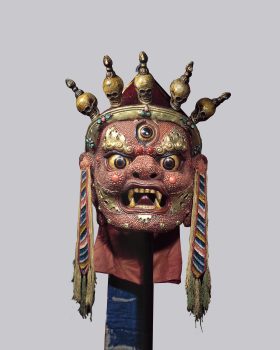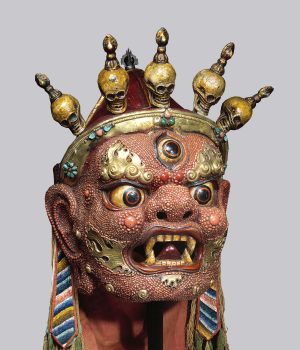Mongolia
early 20th century


Mongolia
early 20th century


Begtse (Mongolian: Jamsaran) is the protector of the leader of Mongolian Buddhism, the Bogda Gegeen, and thus plays a prominent role in Mongolian ritual dance. In Mongolian monasteries an annual masked dance known as tsam focuses on the elimination of negative energies, specifically the exorcism of enemies of the religion and the destruction of forces that obstruct the path to enlightenment. This mask, decorated with roughly six thousand pieces of coral, is quite heavy and would have been worn by a specially selected strong, young monk who could manage the weight. A framework inside enabled the dancer to look out through the mouth. Masks of Begtse like this were made only in Mongolia, and few of them are known to exist.
A religious movement that originated in India around the fifth to seventh century with sacred writings and esoteric teachings and practices transmitted from teacher to student through initiation. These remain an important part of Hinduism and Buddhism today.
A kind of energy that can be used, individually and collectively, to effect change.
Prescribed practices that carry symbolic meaning and value within a specific tradition and are intended to attain a desired outcome. Rituals are usually done as part of a ceremony or regular routine.
Protectors of Buddhist teachings who destroy obstacles that impede the path to enlightenment. The more frightening and gruesome their appearance, the greater their power.
Mongolians have been widely active in the Tibetan Buddhist world, playing a key role in Tibetan culture, politics, and relations with China. In the 13th century, the Mongol Empire—the largest contiguous empire in world history—facilitated the spread of Tibetan visual culture.
Get the latest news and stories from the Rubin, plus occasional information on how to support our work.